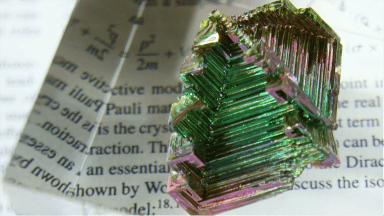Bismuth Unmasked: Rethinking the Topology of a Quantum Puzzle

Date: May 29, 2025
Source: Quantum Server Networks – Materials Science & Quantum Frontier Blog
For nearly two decades, the chemical element bismuth has been a source of both fascination and confusion within the quantum physics and materials science communities. Is it a topological material—or has it merely been pretending to be one?
A recent study led by physicists in Japan, as reported by Physics World, suggests that bismuth's apparent dual nature might not be due to error or uncertainty but rather to a phenomenon known as surface relaxation, which could be “blocking” its true topological identity.
What Makes a Material Topological?
In solid-state physics, topology refers to the global properties of a material’s electronic wavefunctions that remain unchanged under continuous deformations. Just as a doughnut and a coffee mug are topologically equivalent due to their single hole, two electronic systems can be topologically similar even if their microscopic structures differ.
Materials known as topological insulators behave like insulators in their bulk but have conducting states on their surface. These unusual properties arise from the topology of their electronic structures, which is often inferred indirectly from surface measurements.
Bismuth: A Curious Case
Historically, bismuth has played a key role in the development of solid-state physics—it’s central to discoveries like the Seebeck effect, diamagnetism, and the Shubnikov-de Haas effect. However, the status of bismuth as a topological material has remained controversial. Depending on the method used, some experiments suggest it is topologically trivial, while others point to a non-trivial surface structure.
“If you look at the history of solid-state physics, many physical phenomena were found firstly in bismuth,” says Yuki Fuseya, quantum physicist at Kobe University. This legacy spurred Fuseya and collaborators to dive deeper into bismuth’s crystalline and topological behavior.
Surface Relaxation: The Hidden Variable
Using density functional theory (DFT), Rikako Yaguchi from the University of Electro-Communications in Tokyo calculated that bismuth’s surface layers expand or “relax” by 3–6%. While this expansion might seem minor, it significantly alters the shape and symmetry of the surface wavefunctions—effectively changing the material's topological character near the surface.
Kazuki Koie, another researcher on the team, demonstrated that this small relaxation is enough to shift bismuth’s surface into a topologically non-trivial regime, even if its bulk remains trivial. This mechanism, dubbed “topological blocking”, could explain the mismatch between experimental methods such as ARPES (which probes surfaces) and STM (which probes edges or hinges).
A Gateway to Topological Engineering
Understanding topological blocking opens the door to new forms of topological materials engineering. By applying strain, altering crystal symmetry, or modifying the interface between layers, scientists may be able to design or control topological behavior on demand.
This idea is echoed by Zeila Zanolli and Matthieu Verstraete of Utrecht University, who showed that two-dimensional bismuth (“bismuthene”) can switch between topological and trivial states depending on in-plane geometry. The implications for quantum computing, spintronics, and magnetic memory devices are far-reaching.
What’s Next for Bismuth and Topological Materials?
Fuseya’s team is now exploring whether topological blocking might occur in other “borderline” materials like lead telluride and tin telluride. These materials are also near a topological phase transition point, where small tweaks to the crystal lattice can shift their quantum properties dramatically.
“Maybe we can find a way to explain every experiment consistently,” Fuseya notes. If successful, this research could unify theory and experimental findings in a notoriously complex field, while also providing a roadmap for engineering next-generation quantum devices.
Further Reading and Citation
This fascinating study was published in Physical Review B and summarized in Physics World. You can access the original article here: https://physicsworld.com/a/has-bismuth-been-masquerading-as-a-topological-material/
About Quantum Server Networks
Quantum Server Networks is a digital platform highlighting innovations in materials science, condensed matter physics, quantum mechanics, and nanotechnology. We translate cutting-edge research into accessible, engaging content for a global audience of professionals, enthusiasts, and visionaries.
For more posts like this, subscribe and follow us regularly!
#Bismuth #TopologicalMaterials #QuantumPhysics #SurfaceRelaxation #MaterialsScience #DensityFunctionalTheory #QuantumEngineering #Spintronics #QuantumDevices #PhysicsWorld #TopologicalInsulators #QuantumServerNetworks

Comments
Post a Comment